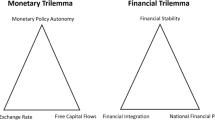Abstract
Over the last few years, central banks in industrial countries have undertaken a variety of policies that deviated from ordinary monetary policy. Why were these policies used? Did they work? What will be the effect of phasing them out? And what long-term concerns do they raise? Clearly, markets were broken, and there was a need to repair them. Some of these innovative instruments seemed to have worked quite well. But now central banks are struggling to get inflation up into their target bands. Large central bank balance sheets may create needed safe, short-term instruments, but take much liquidity management away from the private sector, while tempting governments to use them for other purposes. Sober thinkers need to examine the experience of the last few years and ask again, what should central banks be asked to do and what ought to be the range of actions they can take?
Similar content being viewed by others
References
Borio, Claudio. 2017. Secular Stagnation or Financial System Drag? Business Economics 52 (2): 87–98.
Bräuning, Falk and Victoria Ivashina. 2017. Monetary Policy and Global Banking, NBER Working Paper No. 23316.
Diamond, Douglas, and Raghuram G. Rajan. 2001. Liquidity Risk, Liquidity Creation and Financial Fragility: A Theory of Banking. Journal of Political Economy 109 (2): 287–327.
Greenwood, Robin, Samuel G. Hanson, and Jeremy C. Stein. 2016. The Federal Reserve’s Balance Sheet as a Financial-Stability Tool. In Designing Resilient Monetary Policy Frameworks for the Future. Kansas City: Federal Reserve Bank of Kanasas City.
Krishnamurthy, Arvind, and Annette Vissing-Jorgenson. 2011. The Effects of Quantitative Easing on Interest Rates: Channels and Implications for Policy. Brookings Papers on Economic Activity Fall: 215–287.
Krishnamurthy, Arvind, and Annette Vissing-Jorgenson. 2013. The Ins and Outs of Large-Scale Asset Purchases. In Global Dimensions of Unconventional Monetary Policy. Kansas City: Federal Reserve Bank of Kansas City.
White, William R. 2016. Ultra-Easy Policy: Digging the Hole Deeper? Business Economics 51 (4): 188–202.
Author information
Authors and Affiliations
Corresponding author
Additional information
Delivered as the Adam Smith Award Lecture at NABE’s Annual Meeting on September 25, 2017.
Rights and permissions
About this article
Cite this article
Rajan, R. Unconventional monetary policy and the role of central banks. Bus Econ 52, 189–193 (2017). https://doi.org/10.1057/s11369-017-0059-8
Published:
Issue Date:
DOI: https://doi.org/10.1057/s11369-017-0059-8




